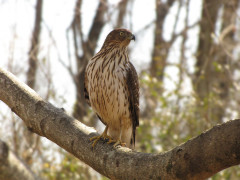Almost everyone is familiar with the migration of the monarch butterfly. Each year, they fly thousands of miles to reach warmer climates in the south and avoid the coldest part of the winter frost. Not many butterflies undertake a journey of this magnitude. In fact, only a few species migrate. Why? Migrating butterflies are not like migrating [Read More …]
Make Sure Their Home Isn’t Your Home: Preventing Unwanted Nests
“There’s a baby bird in my oven!” the concerned caller reported. “How did it get in there?” she asked, “It’s not like we left the oven door open.” Calls like this are not uncommon. Every year, many people seek help after birds nest in their houses, apartments, or office buildings. Most are not aware that cavity nesting birds, such as House [Read More …]
Where Are They In The Winter: Reptiles and Amphibians
Most reptiles and amphibians remain in the same area most of their lives. During the winter they have various techniques to help them survive the colder temperatures, both above water and under it. Many turtles burrow into the ground, either on dry land or in the dense mud at the bottom of lakes, streams, and other bodies of water. The Eastern [Read More …]
Where Are They In The Winter: Mammals
Mammals use a variety of techniques to survive the colder months. Some migrate to warmer climates where food is more readily available. Others remain in their home range, growing thick winter coats and altering their diets. Some mammals, like squirrels will do “pre-season preparation” where they create large caches of foods in the fall that can [Read More …]
Where Are They In The Winter: Birds
Although migratory birds usually garner all the attention, many beautiful birds can be found in our area all winter long. In fact, winter is one of the best times to enjoy your local bird life. With most of the leaves off the trees, visibility is often better and many brightly colored birds such as Northern Cardinals and Blue Jays are easy to spot [Read More …]
Pigeons: Misunderstood But Magnificent!
It is easy to overlook a pigeon. For some people, they are a common and unwanted sight, crowding streets, public squares and parks, and roosting on rooftops. Their ability to thrive in urban environments has earned them “pest status.” Interestingly, this ability to adapt and thrive in a variety of situations is also the very quality that has led [Read More …]
Ben’s Bird: the Wonderful World of Wild Turkeys
Most of us have strong associations with turkeys even if Thanksgiving dinner was not part of our family’s traditional celebration. We learn to identify them at an early age, often by making turkey cutouts for handcrafted Thanksgiving cards, hearing stories about the first Thanksgiving, and learning of Benjamin Franklin's famed appreciation for the [Read More …]
Woodpeckers of Washington D.C.
Known for their long beaks, distinctive drumming, and hard heads, woodpeckers are one of the most common forest birds sighted in Rock Creek Park. They serve an important ecological role in both the creation of cavity nests and the decomposition of dead trees. Their thick skulls, strong beaks, and powerful neck muscles allow them to deliver sharp [Read More …]
Hovering with Hummingbirds
Unless you are near a flowering garden or a nectar feeder, you will likely have a hard time catching sight of a hummingbird. Most hummingbirds zip around at high speeds, weaving skillfully through plants and going from garden to garden in search of their next meal. Able to maneuver around obstacles with deft precision, hummingbirds can come to a [Read More …]
Raptors In Our City
Catching sight of a Cooper’s Hawk is usually just a matter of being attentive. Until a few decades ago, they were considered relatively rare in urban and suburban areas. Today, Cooper’s Hawks are notorious for stalking bird feeders where they can pick off unsuspecting birds for an easy meal. Some studies show that their numbers are actually higher [Read More …]











